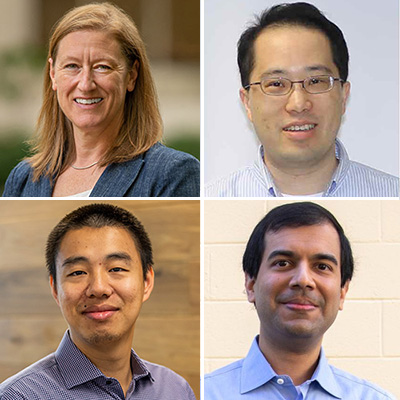The Problem
Secret misconduct settlements can mask a pattern of misbehavior, enabling repeat offenders to continue unabated, shielded from public scrutiny.
Secret misconduct settlements can mask a pattern of misbehavior, enabling repeat offenders to continue unabated, shielded from public scrutiny.
The interdisciplinary research team proposes a statutory-technological framework for creating cryptographically secure misconduct settlement reporting registries.
The protocol calculates oversight statistics on misconduct settlement trends and prevalence while unmasking serial settlers for further, confidential review by prosecutors or regulators.
Professor Xiao Wang, JD/CS PhD student Peter Chan, and Professor Alyson Carrel (Northwestern Pritzker School of Law)
 An interdisciplinary paper coauthored by researchers from Northwestern Engineering and Northwestern’s Pritzker School of Law earned the Best Paper Award at the Fourth Association for Computing Machinery (ACM) Symposium on Computer Science and Law, held March 25 – 27 in Munich.
An interdisciplinary paper coauthored by researchers from Northwestern Engineering and Northwestern’s Pritzker School of Law earned the Best Paper Award at the Fourth Association for Computing Machinery (ACM) Symposium on Computer Science and Law, held March 25 – 27 in Munich.
The winning paper, “Murmurs of the Silenced: Secure Reporting of Misconduct Settlements,” proposes a statutory-technological framework for creating cryptographically secure misconduct settlement reporting registries.
The paper’s collaborators included first author Peter K. Chan, a joint JD/PhD student in computer science; Xiao Wang, assistant professor of computer science at the McCormick School of Engineering; Alyson Carrel, clinical professor of law at the Northwestern Pritzker School of Law; and Mayank Varia, associate professor of computing and data sciences at Boston University.
The decision to resolve legal misconduct via private settlement versus public adjudication reveals a series of wrenching tradeoffs.
By forgoing judicial due process in favor of private settlement, parties may gain quicker resolution and the certainty of an agreed-upon outcome. But the imbalance of bargaining power between disputants and lack of accountability for wrongdoers can result in settlements harmful both to the plaintiff and public. This is exacerbated by settlement non-disclosure agreements (NDAs), which forbid both parties from disclosing the details or very existence of the settlement.
Secret misconduct settlements can mask a pattern of misbehavior, enabling repeat offenders to continue unabated, shielded from public scrutiny. And, while policymakers seek to eliminate safe harbors by banning or restricting NDAs, these efforts can inadvertently harm plaintiffs by reducing their payoffs or likelihood of securing a settlement.
“This project was initially motivated by the #MeToo movement, which exposed how bad actors exploited NDAs to conceal patterns of sexual harassment and assault,” Chan said. “By shielding misconduct from public view, these confidential settlements enabled harmful behavior to continue unchecked against future victims.”
Using secure multi-party computation (MPC), a cryptographic technique that allows parties to jointly compute a function without revealing the underlying data, the team proposed a legal mechanism that enables a secure reporting registry for domain-specific misconduct settlements. Their technical protocol uses secure MPC to calculate oversight statistics on misconduct settlement trends and prevalence while unmasking serial settlers for further, confidential review by prosecutors or regulators — as serial settlers aren’t necessarily serial offenders.
“Our project demonstrates how advanced cryptographic technology can resolve a fundamental tension in our legal system: the conflict between individuals' legitimate interests in private dispute resolution and society's need for transparency,” Wang said. “Rather than forcing policymakers to choose between banning NDAs entirely or allowing them without restriction, our approach offers a third path that preserves both individual privacy and public oversight simultaneously.”
Xiao WangAssistant Professor of Computer Science at Northwestern Engineering
The settlement statistics generated by the team’s system could also help improve settlement efficiency, by speeding up the initial settlement negotiations, and serving as a guidepost for the settlement amount.
To test scalability, the research team built a general settlement processing prototype with an off-the-shelf MPC software library. The system processed hundreds of thousands of settlements in a few hours, using mid-range consumer hardware, while computing useful statistics and finding repeat settlers.
“The legal and dispute resolution professions have traditionally been cautious about embracing new technologies, so this recognition helps highlight how technological and innovative solutions can transform seemingly intractable legal problems,” Carrel said. “I hope our work inspires more legal scholars and practitioners to explore technological innovations that can resolve longstanding tensions in our justice system.”
Moving forward, the team aims to explore the practical implementations of their secure reporting framework in additional domains, including environmental pollution and employment law, to demonstrate the system’s versatility and encourage adoption by policymakers. In addition, Carrel and Chan formulated a privacy-transparency settlement matrix to balance the dual goals of individual privacy with societal oversight.
Northwestern CS+Law researchers are building new theoretical, methodological, and translational frameworks to address increasingly pressing societal challenges, including, cryptography and information security, fairness, privacy, and reliability and trust in machine learning and AI systems.
This collaboration between Northwestern legal scholars and computer scientists doesn't just combine different perspectives, it fundamentally shifts what's possible. JD/CS PhD student
“Interdisciplinary research and collaboration are ubiquitous at Northwestern, and the CS+Law initiative is one paradigmatic example of that culture,” Chan said. “This collaboration between Northwestern legal scholars and computer scientists doesn't just combine different perspectives, it fundamentally shifts what's possible. By bridging these disciplines, we're transforming theoretical legal frameworks into practical technological solutions that respect both individual privacy rights and society's need for transparency.”
The ACM Symposium on Computer Science and Law is a leading venue for cross-disciplinary scholarship at the intersection of computer science and law. Daniel W. Linna Jr., senior lecturer and director of law and technology initiatives at Northwestern, and Sarah B. Lawsky, Howard Friedman '64 JD Professor of Law at Northwestern Pritzker Law, were members of the ACM CS+Law 2025 program committee.
Northwestern contributions to the ACM CS+Law 2025 conference also included: